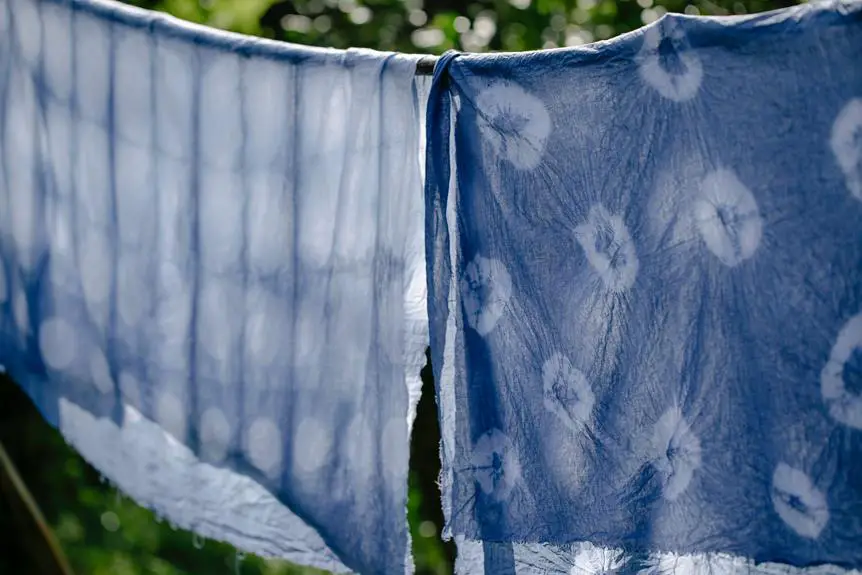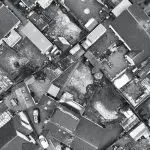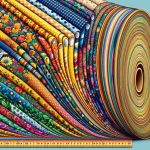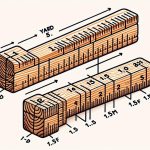You know the saying, 'Measure twice, cut once'? Well, when it comes to fabric math, knowing how many yards are in 504 inches can save you time, money, and frustration.
In this guide, we'll walk you through the process of converting inches to yards with ease and precision. By the end, you'll have the mastery to confidently tackle any fabric measurement challenge.
So, let's dive in and demystify the yardage calculation, empowering you to make accurate estimations and avoid costly mistakes.
Key Takeaways
- Yardage conversion is essential for accurate fabric estimation.
- To convert from inches to yards, divide the number of inches by 36.
- Understanding this conversion allows for precise fabric estimation.
- Accurate fabric estimation ensures the success of sewing projects.
Understanding the Yard-Inch Conversion
To understand the yard-inch conversion, you need to know how many inches are in a yard and how to convert between the two units. Yardage conversion is essential for accurate fabric estimation. A yard consists of 36 inches. This fundamental conversion factor forms the basis for all yard-inch calculations.
When estimating fabric for a project, being able to convert between yards and inches is crucial. By mastering this conversion, you can ensure you purchase the correct amount of fabric, avoiding the inconvenience of running out mid-project or the wastage of excess material.
To convert from yards to inches, simply multiply the number of yards by 36. Similarly, to convert from inches to yards, divide the number of inches by 36. Understanding this conversion allows for precise fabric estimation, making it easier to plan and execute sewing, quilting, or crafting projects.
Converting 504 Inches to Yards
So, you want to convert 504 inches to yards? It's actually pretty straightforward!
Let's break it down and calculate the yardage step by step.
I'll show you some handy tips for measuring fabric accurately.
Inches to Yards Conversion
You frequently measure fabric in inches, but do you know how to convert 504 inches to yards?
When it comes to yardage estimation and fabric conversion, understanding the inches to yards conversion is essential for accurate measurements.
To convert inches to yards, you can use the simple conversion factor: 36 inches equals 1 yard.
So, to convert 504 inches to yards, you'd divide 504 by 36. This gives you 14, meaning there are 14 yards in 504 inches.
Understanding this conversion allows you to effectively plan for your fabric needs, ensuring you purchase the correct amount for your project.
Mastering the conversion from inches to yards empowers you to work with fabric measurements confidently, knowing you can accurately convert between the two units.
Simple Yardage Calculation
Calculating the yardage for 504 inches of fabric involves dividing the inches by 36, yielding 14 yards for your project.
When estimating fabric for a project, accuracy is crucial. Here's a simple yardage calculation to convert 504 inches to yards:
- Divide the total inches by 36 (504 ÷ 36 = 14).
- Round up to the nearest whole number if you have a fraction of a yard.
- Consider adding a bit extra for seam allowances and pattern matching.
- Always double-check your measurements to ensure accuracy.
Fabric Measurement Tips
Continuing from the previous subtopic, when estimating fabric for your project, remember to account for seam allowances and pattern matching when converting 504 inches to yards. To make accurate fabric estimations, it's crucial to understand fabric estimation techniques and sewing project yardage. Here's a helpful table to simplify the conversion process:
| Inches | Yards |
|---|---|
| 504 | 14 |
When converting 504 inches to yards, simply divide the total inches by 36 (since there are 36 inches in a yard). For more complex calculations, it's beneficial to use a fabric yardage calculator or consult the pattern instructions. Taking the time to calculate fabric yardage accurately can help prevent fabric shortages and ensure the success of your sewing projects.
Utilizing the Fabric Measurement Formula
To determine the number of yards in 504 inches of fabric, one can use the fabric measurement formula. Follow these steps to utilize the fabric measurement formula effectively:
- Understand the Conversion: Know that there are 36 inches in a yard. This conversion is crucial when working with fabric measurements.
- Divide the Total Inches: Divide the total inches of fabric by 36 to convert it into yards. In this case, 504 inches divided by 36 equals 14 yards.
- Round Off if Necessary: If the result includes a decimal, round it off to the nearest whole number. For instance, if the calculation resulted in 14.25 yards, round it off to 14 yards.
- Double-Check the Measurements: Always double-check your measurements to ensure accuracy. This extra step is essential for yardage estimation accuracy.
Simplifying the Yardage Calculation
Let's talk about simplifying the yardage calculation.
Converting inches to yards can be a bit tricky, but understanding fabric measurements is key.
We'll break it down and make it easier for you to calculate the yardage needed for your sewing projects.
Converting Inches to Yards
Converting inches to yards simplifies the yardage calculation, helping you accurately measure fabric for your project. Here's how to do it:
- Understand the Conversion: There are 36 inches in a yard, so when converting inches to yards, divide the total inches by 36.
- Use the Formula: To convert inches to yards, use the formula: Yards = Inches / 36.
- Round to Nearest Yard: After calculating the yardage, round it to the nearest whole number for practical purposes.
- Adjust for Waste: Consider adding a little extra fabric for seam allowances, pattern matching, and any potential mistakes.
Mastering the conversion from inches to yards will make it easier to accurately estimate the fabric needed for your sewing or crafting projects.
Understanding Fabric Measurements
You frequently encounter fabric measurements when planning sewing or crafting projects. Understanding fabric measurements is crucial for accurate fabric estimation and measurement accuracy. When working with fabric, it's essential to be able to calculate and convert between different units of measurement. Here's a helpful table to simplify the yardage calculation:
| Measurement | Inches | Feet | Yards |
|---|---|---|---|
| 1 Yard | 36 | 3 | 1 |
| 1 Foot | 12 | 1 | 0.33 |
| 1 Inch | 1 | 0.08 | 0.03 |
Simplifying Yardage for Sewing
A clear understanding of fabric measurements will help you simplify yardage calculations for your sewing projects, saving you time and ensuring accurate fabric estimation. Here are four essential tips to simplify your yardage calculation for fabric cutting:
- Understand Your Pattern: Carefully review your sewing pattern to identify the specific yardage required for your project. The pattern instructions often provide guidance on the amount of fabric needed based on the size and style of the garment.
- Consider Fabric Width: Take into account the width of the fabric you plan to use. Most fabric bolts come in standard widths, typically 45 or 60 inches. Adjust your yardage calculation based on the fabric width to ensure you purchase the correct amount.
- Factor in Pattern Repeats: If your fabric has a distinct pattern or print, you may need additional yardage to match the design across seams or sections.
- Add Extra for Safety: It's wise to add a bit of extra yardage to account for any errors during cutting, unexpected fabric shrinkage, or for future alterations.
Exploring Practical Examples
To calculate how many yards are in 504 inches, simply divide 504 by 36, because there are 36 inches in a yard.
In practical applications, understanding this conversion can be highly beneficial, especially in real-life scenarios such as sewing projects or fabric shopping.
For instance, if you have 504 inches of fabric and need to know how many yards it is, dividing by 36 will give you the answer. This knowledge can save time and effort when estimating fabric yardage for a project.
In real-life scenarios, let's say you're making curtains and the fabric store sells fabric by the yard. By knowing that 504 inches is equivalent to 14 yards, you can quickly determine how much fabric to purchase without any guesswork.
Mastering this simple fabric math not only allows for accurate measurements but also empowers you to make informed decisions when working on sewing or crafting projects.
Understanding these basic principles can make a significant difference in ensuring the success of your fabric-related endeavors.
Tips for Accurate Fabric Yardage Estimation
When estimating fabric yardage, consider the pattern of the fabric and measure it accurately to avoid any miscalculations. Here are some tips for accurate fabric yardage estimation:
- Understand the Fabric Pattern: Take note of the pattern repeat and direction. If the fabric has a large repeat or is directional, you may need more yardage to ensure pattern matching.
- Measure Twice, Cut Once: Before purchasing fabric, measure the length and width of the pattern pieces you plan to cut. Add extra yardage for seam allowances, hems, and pattern matching.
- Consult a Fabric Yardage Chart: Many patterns provide fabric yardage requirements based on the width of the fabric. Use these charts as a starting point, but always double-check by measuring your actual pattern pieces.
- Consider the Fabric Type: Different fabrics have varying widths, so the yardage required can differ. For example, a wide fabric may require less yardage for a project compared to a narrower fabric.
Common Mistakes to Avoid
Avoid overestimating fabric yardage by carefully considering the pattern repeat and direction, as well as measuring precisely for your sewing project.
Common mistakes in fabric estimation often stem from overlooking these crucial factors. One of the most frequent errors is failing to account for the pattern repeat when calculating yardage. Ignoring this can result in purchasing insufficient fabric or even pattern elements being cut off.
Another pitfall isn't taking into consideration the fabric's directionality. Forgetting to align pattern pieces with the fabric's grain can lead to a distorted or asymmetric final product, requiring additional yardage to rectify.
Yardage accuracy also suffers when measurements are imprecise. Inaccurate measuring can cause fabric shortages or leftovers, both of which can be costly. To ensure precise fabric estimation, always double-check your measurements and consider adding a margin for error.
Conclusion and Next Steps
Continue the discussion from the previous subtopic into the current subtopic by reflecting on how precision in fabric estimation can significantly impact the outcome of your sewing projects.
When it comes to sewing, precision in yardage estimation can make or break your project. Here are a few practical applications and yardage estimation techniques to keep in mind as you move forward:
- Project Planning: Accurate fabric estimation is crucial for planning your sewing projects. It ensures that you have enough fabric to complete your project without running short or ending up with excessive leftovers.
- Cost Efficiency: Precise yardage estimation helps in minimizing fabric wastage, which can lead to cost savings in the long run. This is especially important when working with expensive or limited-edition fabrics.
- Pattern Matching: When working with patterned or directional fabrics, accurate yardage estimation ensures that you have enough fabric to properly match patterns and maintain the desired aesthetic.
- Variations in Fabric Width: Being mindful of variations in fabric width is essential for accurate yardage estimation. Some fabrics come in wider or narrower widths, impacting the amount of fabric needed for a project.
Mastering these yardage estimation techniques will enhance your sewing skills and lead to more successful and satisfying sewing projects.
Frequently Asked Questions
Can I Use the Same Formula to Calculate Yards From Inches for Different Types of Fabric, Such as Stretchy or Sheer Materials?
Yes, you can use the same formula to calculate yards from inches for different types of fabric, such as stretchy or sheer materials. Consider the fabric pattern and directional prints when measuring for accuracy.
Are There Any Specific Considerations or Adjustments Needed When Converting Inches to Yards for Patterned or Directional Fabrics?
When converting inches to yards for patterned fabrics, consider pattern repeat and direction. Make adjustments based on fabric layout. For directional fabrics, additional yardage may be needed to ensure pattern alignment. Always account for these considerations when working with patterned or directional fabrics.
How Do I Account for Shrinkage or Fabric Loss When Calculating Yardage From Inches?
When calculating yardage from inches, account for shrinkage and fabric waste. For stretchy materials, add extra length. Patterned fabrics may require more yardage for matching. Always buy a bit more to be safe.
Are There Any Standard Industry Practices or Guidelines for Rounding up or Down When Converting Inches to Yards?
When converting inches to yards, standard industry practices suggest rounding up to account for fabric variations and pattern direction. It's important to consider fabric weight and potential shrinkage, so always factor those in as well.
What Are Some Common Challenges or Complications That Can Arise When Estimating Fabric Yardage From Inches, and How Can They Be Addressed?
When estimating fabric yardage from inches, challenges can arise in estimating accuracy and measurement consistency. To address this, ensure precise measurements and consider potential fabric shrinkage, pattern matching, and seam allowances.
- Is Chiffon a Lightweight? - April 23, 2024
- Is Chiffon Cool in Hot Weather? - April 23, 2024
- Is Pure Chiffon Costly? - April 23, 2024








